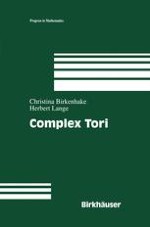1999 | OriginalPaper | Buchkapitel
Nondegenerate Complex Tori
verfasst von : Christina Birkenhake, Herbert Lange
Erschienen in: Complex Tori
Verlag: Birkhäuser Boston
Enthalten in: Professional Book Archive
Aktivieren Sie unsere intelligente Suche, um passende Fachinhalte oder Patente zu finden.
Wählen Sie Textabschnitte aus um mit Künstlicher Intelligenz passenden Patente zu finden. powered by
Markieren Sie Textabschnitte, um KI-gestützt weitere passende Inhalte zu finden. powered by
To any smooth projective curve C one can associate an abelian variety, the Jacobian variety J(C). In [W2] Weil showed that, more generally, to any smooth projective variety M of dimension n and any p ≤ n, one can associate an abelian variety, the p-th intermediate Jacobian of M. It has, however, the disadvantage that it does not depend holomorphically on M in general. It was Griffiths’ idea to modify the definition in such a way that the new intermediate JacobianJ G P(M) varies holomorphically on with M. It is a complex torus, but in general not an abelian variety. It admits, however, a class of line bundles whose first Chern class is a nondegenerate hermitian form. This is a special case of the following situation: Let X be a complex torus of dimension g and H ∈ NS(X) a nondegenerate hermitian form. Suppose k denotes the index of H, that is, the number of negative eigenvalues of H. We call such a hermitian form a polarization of index k. (Note that in [G] H is called a k-convex polarization). If H is a polarization of index k on a complex torus X, we call the pair (X, H) a nondegenerate complex torus of index k. In view of the definition of a pseudo-Riemannian manifold [He] one might be tempted to call (X, H) a pseudo-abelian or semi-abelian variety, but these notions have already a different meaning. Note that a nondegenerate complex torus of index 0 is a polarized abelian variety. It is the aim of this chapter to derive the main properties of nondegenerate complex tori of index k.
